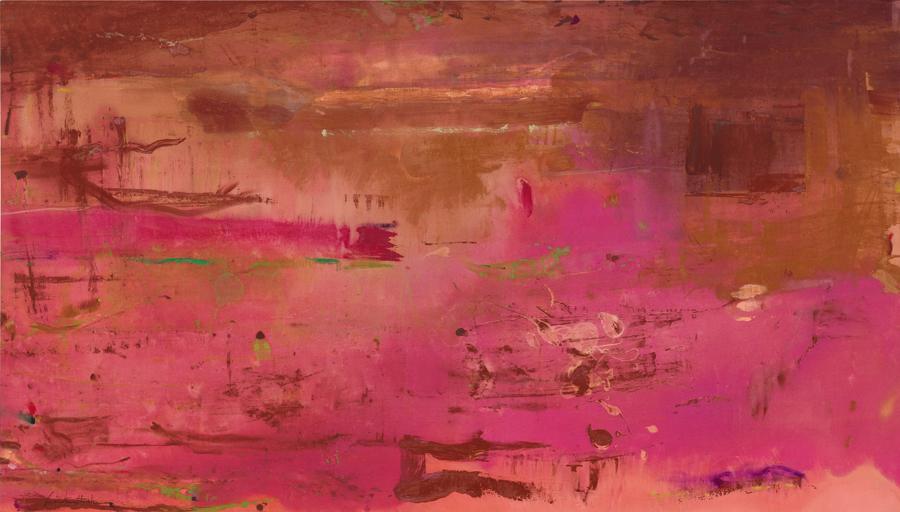Sea of Change: Helen Frankenthaler Review
An exhibition in Rome explores how a move to an ocean-side home effected a transitional late period in this major artist’s work
An exhibition in Rome explores how a move to an ocean-side home effected a transitional late period in this major artist’s work

There is a five-minute video of rare archival footage of Helen Frankenthaler that captures her essence: a deeply intelligent, deliberate yet experimental painter, poised and forceful at the same time. ‘One cliché I use on myself all the time,’ she says, ‘is the one rule is no rules. And if you have a real sense of limits then you’re free to break out of them’. She pauses as she gestures regally, her arm drawing a line: ‘The end’.
Frankenthaler, whose career spanned six decades, was one of the great American painters of the 20th century, a leading abstract expressionist whose pioneering ‘soak-stain’ technique proved pivotal to the shift to Colour Field painting in the 1950s. Born into a privileged Upper East Side family, Frankenthaler was encouraged from a young age to pursue her passion. Shortly after she graduated she met the eminent art critic Clement Greenberg, who proved crucial in propelling her into the New York avant-garde scene. She befriended the likes of Jackson Pollock, Willem De Kooning and Franz Kline, transitioning from what she wryly called ‘college Cubism’ to abstract expressionism. Later, she was married to Robert Motherwell; they were known as the ‘Golden Couple’.

Words such as lyrical, beautiful, and atmospheric repeatedly crop up – both as criticism and praise – when describing her work. An enduring accusation was she was not ‘tough’ enough in her work as, say, Joan Mitchell was – Frankenthaler’s paintings were considered too soft, too ‘feminine’. The young artist seemed impervious to criticism, exhibiting instead a remarkable sense of confidence and authority as she pursued her own trajectory, continually experimenting with how colour could define space.
Currently, two shows in Venice and Rome curated by the Frankenthaler scholar John Elderfield offer a rare chance to see her work in Italy. While the Palazzo Grimani show spans four decades of her career, the Gagosian exhibition in Rome offers an in-depth study of her work through 11 paintings. Deftly curated by Elderfield, ‘Sea Change: A Decade of Paintings 1974 to 1983’ posits that Frankenthaler’s move to a waterfront home in Shippan Point, Connecticut, was the catalyst for a period of significant change.

Frankenthaler’s preoccupation with lines creating shapes, whether by bands of paint or, as in her earlier works, black ‘ropes or lassos’ as she called them, have given way to a concern with the physicality of the surface – arguably informed by the ultimate surface itself, the vast blue expanse of ocean she saw daily. In Ocean Drive West #1 (1974), a supple, almost ‘classic’, monochromatic ocean view of varying degrees of brilliant blues, is contrasted with lighter, transparent blue horizontal lines alluding to waves, while intermittent details of brown recall land.
It could be argued that the enduring legacy of Frankenthaler’s paintings is that, no matter how abstract, or imbued in theory, they invariably tap into the human psyche, offering glimpses of intimate emotions, experiences. Dream Walk Red (1978) is a case in point. A powerful example of Frankenthaler attempting to ‘do more to each painting’, it is a densely layered symphony of vigorous red, fuchsia and sienna interwoven with horizontal hues of darker paint with the odd green. The canvas is so complex – and large – you could study the minutiae endlessly. Certain elements project forward while others hover in the distance. It’s like stepping into someone else’s dream.

Sacrifice Decision (1982) represents a marked change – the canvas is no longer densely painted, but diluted, lighter. Crucially, it represents the introduction of ‘blobs’ or ‘clumps’ (Frankenthaler’s own terms). Set against a beige backdrop, a smoky plume-like shape floats across the middle, as thick, bold clumps of lilac-grey are clustered around it. These are the result of grey paint poured forcefully onto the canvas and then flooded with water. The blobs float on the surface, seemingly arising from a receding background. Of the painting, Frankenthaler said: ‘Returning, I thought, should I blend in the clumps while they’re still wet. Yet, the picture dictated not to touch it. I said to myself, decide, you can’t have it all ways. I suppose that’s why it’s called Sacrifice Decision – in the end it was no sacrifice.’
The latest piece in the show and one of its best is Tumbleweed (1983). Here, bright red, blue and black pigments dance across the small green canvas as dabs, dots or dashes. The surface is no longer smoky or romantic, but firmly on land. Still, the painting draws you in; you feel like you could almost touch the tumbleweeds as they dance in the wind.
Main image: Helen Frankenthaler, Shippan Point: Twilight, 1980, acrylic on fabric, 1.8 × 1.4 m. Courtesy: Gagosian





















